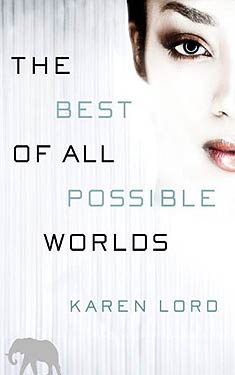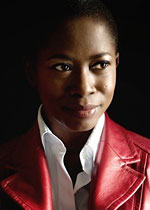WoGF Review: The Best of All Possible Worlds by Karen Lord
 Wendy B. (nightxade): My brother introduced me to science fiction, fantasy and comics when I was barely out of diapers and LeVar Burton encouraged my love of reading throughout my youth. If my love of reading is the only legacy I can pass forward to my little geeklings, I would be a very happy mom. (If they pick up my love of gaming, writing and their dad’s love of cooking, too, then that would be even better!). Now I happily share my bibliophilia with my fellow bibliophiles at bibliosanctum.blogspot.com.
Wendy B. (nightxade): My brother introduced me to science fiction, fantasy and comics when I was barely out of diapers and LeVar Burton encouraged my love of reading throughout my youth. If my love of reading is the only legacy I can pass forward to my little geeklings, I would be a very happy mom. (If they pick up my love of gaming, writing and their dad’s love of cooking, too, then that would be even better!). Now I happily share my bibliophilia with my fellow bibliophiles at bibliosanctum.blogspot.com.
Editor’s note: This review was submitted in last month and counts for the May review poll.
 The Best of All Possible Worlds takes place in a distant future, featuring varied species of humans separated by different planets and genetic developments that result in some differences in appearance and mental abilities. Many of these people are brought together by various tragedies to the planet known as Cygnus Beta. The story takes place shortly after the heinous destruction of Sadira, home to a stoic race of people who pride themselves on mental disciplines that have resulted in a level of telepathic communication and emotional control. These elements define the book as “science fiction,” but in truth, this is a wonderful, quiet little love story. Not that this is merely a romance set in space. The science fiction aspect remains prominent, but it is the interpersonal relationships and sociological studies that are at the story’s heart.
The Best of All Possible Worlds takes place in a distant future, featuring varied species of humans separated by different planets and genetic developments that result in some differences in appearance and mental abilities. Many of these people are brought together by various tragedies to the planet known as Cygnus Beta. The story takes place shortly after the heinous destruction of Sadira, home to a stoic race of people who pride themselves on mental disciplines that have resulted in a level of telepathic communication and emotional control. These elements define the book as “science fiction,” but in truth, this is a wonderful, quiet little love story. Not that this is merely a romance set in space. The science fiction aspect remains prominent, but it is the interpersonal relationships and sociological studies that are at the story’s heart.
The story is mainly told by Grace Delarua, a 30-something Cygnus Beta native of mixed race, who works with a contingent of Sadiri people seeking to perpetuate their dwindling culture. The author explains that she was inspired by the 2004 Indian Ocean tsunami that killed a large percentage of females and forced those remaining to relocate and adjust to their new surroundings. On Cygnus Beta, there are several taSadiri societies that the group must visit to determine genetic potential for Sadiri males. Having left Sadira long before, the taSadiri have developed in many different ways, from a society that patterns itself after fantasy lore, to an incestuous mess of classism and many more in between. The goal of Delarua’s group is to maintain Sadiri disciplines and genetics as much as possible through suitable pairings, but as they progress, they find that this is not an easy task.
The operation is rather clinical, yet it is never implied that people would be paired against their will or even without emotional attachment, and I appreciate that the clinical aspect did not become overwhelming but was, in fact a further insight into the Sadiri way of life.
Delarua’s group includes Councillor Dllenahkh, who is the epitome of a culture that has several different meanings for the word “appropriate.” It becomes obvious to all but Delarua that these two will eventually become a pair. What I enjoyed most about their relationship was that it was not at all the typical case of putting the emotional lady with the emotionally subdued man and watching the sparks fly as she teaches him how to feel. Instead, we get a very slow character and relationship building, climaxing in a bonding that I cannot help but find adorable (I do not use that word lightly!) because of how it embraces those differences between them, even as they speak in technical terms and sign contracts to cement their future.
Several important events occur during the book – an attempted murder, a nigh tragedy, a political scandal, family abuse, time travel – but they all serve as backdrop and motivation for the character growth, rather than as plot focus elements themselves.
Reading this book gave me the feeling of being comfortable no matter where I was. I felt like I was sitting in my cozy reading chair with these characters, enjoying the story as it quietly unfolded. It’s probably not a coincidence that the story is told in the first person by Delarua, who has the innate ability to calm those around her, even while being a very emotionally expressive person with empathic abilities.
The Sadiri could easily be written off as Vulcan-like, but that is far from the truth. They do not suppress their emotions, they simply do not express them as obviously. The magic of the story comes in Delarua’s growing understanding of their culture – through her research as well as her empathy, which allows her ability to recognize their minute expressions of emotion. The Sadiri are quite capable of emotion, but a good belly laugh to us, might appear as a shared twinkle in their eyes and a curve of the lips, and because Delarua tells most of the story, we are permitted to learn and feel all of this with her.
 I occasionally found myself feeling like I’d missed something in the details, but towards the end of the book, everything fell into the place nicely and I realized that the details I felt I was missing were details Delarua did not quite know or Dllenahkh had not quite revealed. It was all a part of learning along with Delarua as she grew in her understanding of the Sadiri and of herself.
I occasionally found myself feeling like I’d missed something in the details, but towards the end of the book, everything fell into the place nicely and I realized that the details I felt I was missing were details Delarua did not quite know or Dllenahkh had not quite revealed. It was all a part of learning along with Delarua as she grew in her understanding of the Sadiri and of herself.
Overall, a fantastic read with very unique memorable characters and I have to thank Goodreads for recommending Karen Lord’s first book to me, Redemption in Indigo. I had not yet read the latter, but upon seeing Lord’s name on this book, I decided to grab it and am very glad I did.



















 Full Details
Full Details


2 Comments
Interesting. Might the Sadiri be an allegory for the functionally autistic?
An interesting theory, but no, I really didn’t find anything remotely abnormal about them. They weren’t repressed in any way. They show emotion just as easily as anyone. They just do so differently. I noticed a lot of reviews that immediately compared them to Vulcans, but I found this comparison very narrow.
Sorry, the comment form is closed at this time.